Best Landscaping Plants for Your Missouri Yard
BY JUDITH GALLOVA | MAY 24TH, 2023 | LAWN CARE, MISSOURISo, you just installed a new lawn, and you want to finish off your landscaping with some stunning plants. But not all plants are ideal for Missouri’s climate, which ranges from cold and snowy in winter to steamy in the summer. Consider going with landscaping plants that look great and are well-adapted to our climate.
Here are 13 plants that grow naturally in Missouri and are well-suited to the state’s climate and soil conditions.
In this article:
- 13 Native Missouri Plants
- Eastern Redbud (Cercis Canadensis)
- Prairie Blazing Star (Liatris Pycnostachya)
- Lance-Leaved Coreopsis (Coreopsis Lanceolata)
- Aromatic Aster (Symphyotrichum Oblongifolium)
- American Beautyberry (Callicarpa Americana)
- Purple Coneflower (Echinacea Purpurea)
- Butterfly Milkweed (Asclepias Tuberosa)
- Downy Phlox (Phlox Pilosa)
- Black-Eyed Susan (Rudbeckia Hirta)
- Zigzag Goldenrod (Solidago Flexicaulis)
- Wild Hydrangea (Hydrangea Arborescens)
- Flowering Dogwood (Cornus Florida)
- Pawpaw (Asimina Triloba)
- How to Create a Stunning Missouri Yard
13 Native Missouri Plants
Native plants are not only accustomed to the local climate and soil conditions, but they also provide essential habitat and food for native wildlife. By incorporating native plants into your landscaping, you create an easy-care, biodiverse environment and reduce chemical usage.
Take a look at these 13 examples of Missouri natives.
Tip: Are you located in St. Louis? Check out our grass guide and our native plant guide for the area.
1. Eastern Redbud (Cercis Canadensis)
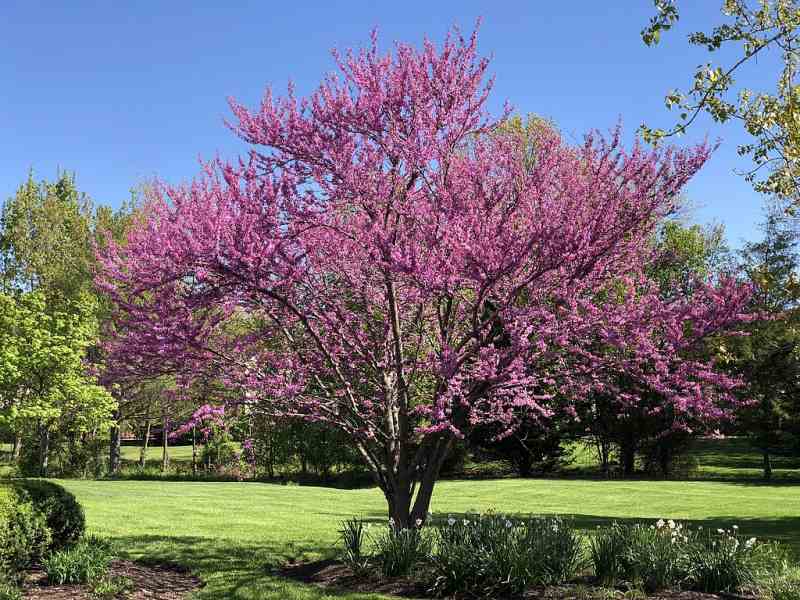
Photo Credit: Famartin / Wikimedia Commons / CC BY-SA 4.0
Eastern redbud bursts with dainty, pink flowers early in the spring, even before its leaves emerge. It makes your yard look stunning and attracts pollinators such as bees and butterflies, adding beauty and biodiversity to your outdoor space.
However, take note that Eastern redbud tends to struggle against some diseases and insects, so extra preventive care will be needed alongside other maintenance.
Plant type: Tree
Sun: Full sun to partial shade
Water needs: Moderate
Soil: Prefers at least a moderate level of fertility, well-drained, consistently moist but not wet
Duration: Perennial
Mature height: 20 to 30 feet
Potential hazards: No major hazards known for people or common (large) pets, but caution is always advised
2. Prairie Blazing Star (Liatris Pycnostachya)
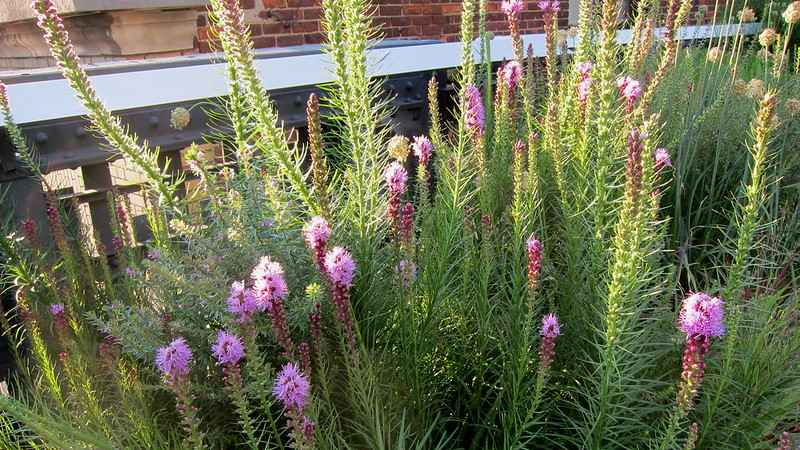
Photo Credit: cultivar413 / Flickr / CC BY 2.0
A real showstopper, the prairie blazing star is sure to catch the attention of anyone that visits your yard, including wildlife. This summer bloomer produces beautiful purple flowers, can grow up to 4 feet tall, and needs minimum maintenance. Prairie blazing star rarely faces problems with diseases or insect pests, too.
Plant type: Flower
Sun: Full sun
Water needs: Keep soil dry or moderately moist
Soil: Average, well-drained
Duration: Perennial
Mature height: 2 to 5 feet
Potential hazards: No major hazards known for people or common pets, but caution is always advised
3. Lance-Leaved Coreopsis (Coreopsis Lanceolata)
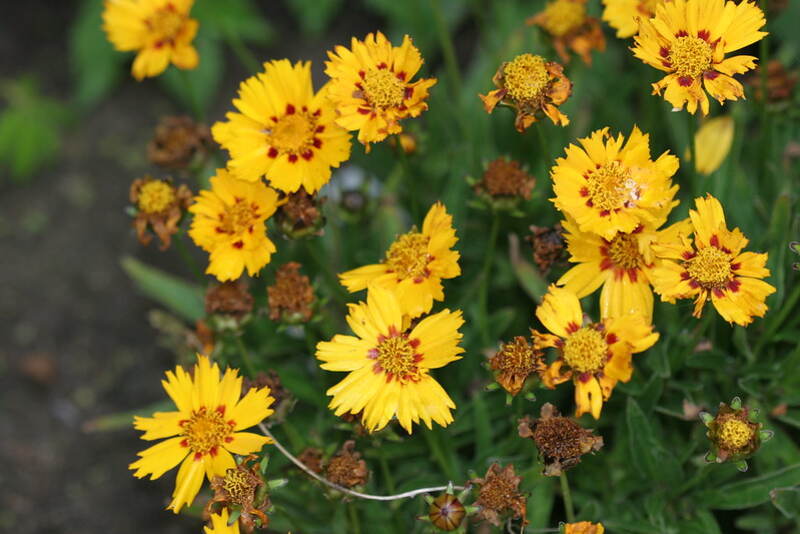
Photo Credit: Andrey Zharkikh / Flickr / CC BY 2.0
Lance-leaved coreopsis, also known as tickseed, is a yellow wildflower that’s both pleasant to the eye and appealing to wildlife such as pollinators and birds. It grows up to 3 feet tall even in dry conditions and spreads easily. Just be careful that your lance-leaved coreopsis doesn’t end up overtaking your yard!
Coreopsis species are usually seen as non-toxic, but there are some reports of lance-leaved coreopsis being toxic to livestock, so be cautious.
Plant type: Wildflower
Sun: Full sun
Water needs: Keep the soil dry or moderately moist
Soil: Loamy, sandy, dry to medium moisture, well-drained; ideally poor, sandy or rocky soils
Duration: Perennial
Mature height: 1 to 3 feet
Potential hazards: Some reports of toxicity
4. Aromatic Aster (Symphyotrichum Oblongifolium)
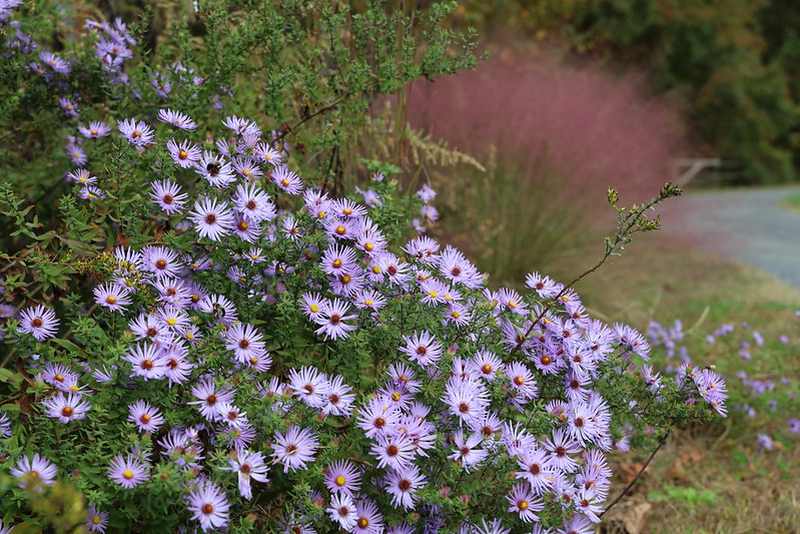
Photo Credit: Lydia Fravel / Flickr / CC BY 2.0
Aromatic aster blooms with purple, daisy-like flowers. Although the flowers themselves aren’t particularly fragrant, the flowerheads and foliage give off a balsam-like smell when crushed. The aromatic aster is easy to care for and keep healthy, and it attracts wildlife like bees and butterflies. The threatened checkerspot butterfly even uses the aromatic aster as its host plant.
Plant type: Flower
Sun: Full sun
Water needs: Soil should be dry to moderately moist
Soil: Clay or sandy
Duration: Perennial
Mature height: 1 to 3 feet
Potential hazards: Lack of data, but some aster variants are reported to be toxic, so practice caution
5. American Beautyberry (Callicarpa Americana)
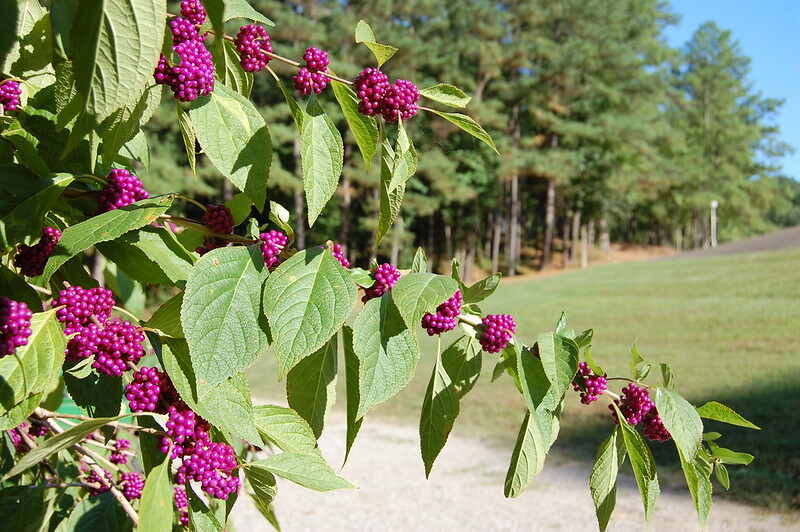
Photo Credit: Donald Lee Pardue / Flickr / CC BY 2.0
The American beautyberry produces small pink flowers in the spring and a showy display of purple berries in the fall. The berries not only stand out with their bright color, but are also a real treat for various songbirds. Moreover, American beautyberry is an easy-care plant that’s relatively resistant to drought and insects.
Although some sources report the berries to be non-poisonous for humans, it’s better to act with caution because they may have mild toxic effects. Moreover, there’s a lack of data surrounding toxicity to domestic animals, so it’s better to keep them from eating any part of the plant.
Plant type: Shrub
Sun: Full sun
Water needs: Low
Soil: Clay, loamy, sandy, moist, well-draining, rich in organic matter; tolerant of various soil types as long as it gets good drainage
Duration: Perennial
Mature height: 3 to 8 feet
Potential hazards: Mild toxic effects reported; a lack of data regarding toxicity to pets
6. Purple Coneflower (Echinacea Purpurea)
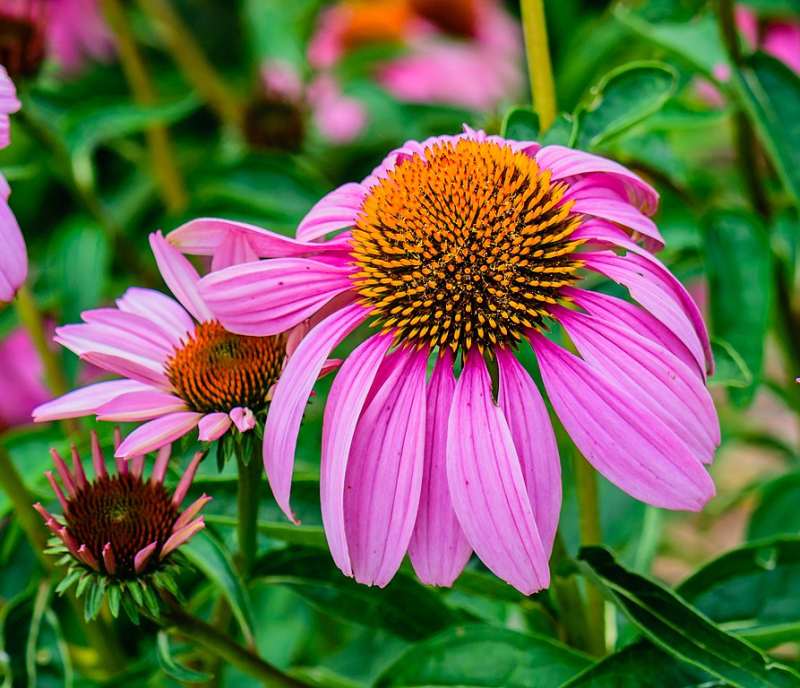
Photo Credit: PumpkinSky / Wikimedia Commons / CC BY-SA 4.0
If you want your yard to turn into a purple paradise in the summer, purple coneflower is another flower to add to it. It produces lovely, bright purple petals, and also provides food for pollinators and birds. The plant is self-seeding, although you may need to divide its clumps every few years. Also, note that the purple coneflower may sometimes suffer from diseases.
The plant is toxic to people and animals so make sure you enjoy it with your eyes only.
Plant type: Flower
Sun: Full sun or partial shade (does best in full sun)
Water needs: Keep the soil dry or moderately moist
Soil: Average, well-drained
Duration: Perennial
Mature height: 2 to 5 feet
Potential hazards: Toxic
7. Butterfly Milkweed (Asclepias Tuberosa)
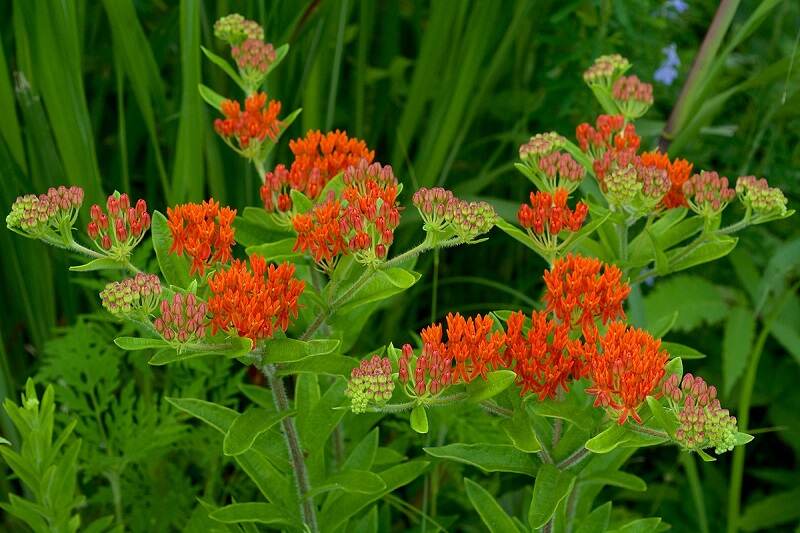
Photo Credit: Eric Hunt / Wikimedia Commons / CC BY-SA 4.0
The butterfly milkweed, also known as butterfly weed and orange milkweed, is listed on the Missouri Botanical Garden’s Plants of Merit, meaning that it grows outstandingly well in Missouri and surrounding regions. It’s an easy-care plant that tends to resist diseases and insect pests and isn’t invasive in the area.
Butterfly milkweed establishes in 2 to 3 years and then produces beautiful, atypical orange blossoms that produce nectar for pollinators. Moreover, milkweed is the only host plant for the monarch butterfly.
Plant type: Herb
Sun: Full sun
Water needs: Low
Soil: Sandy, poor, average, dry to medium, well-drained
Duration: Perennial
Mature height: 1 to 2 feet
Potential hazards: Toxic
8. Downy Phlox (Phlox Pilosa)
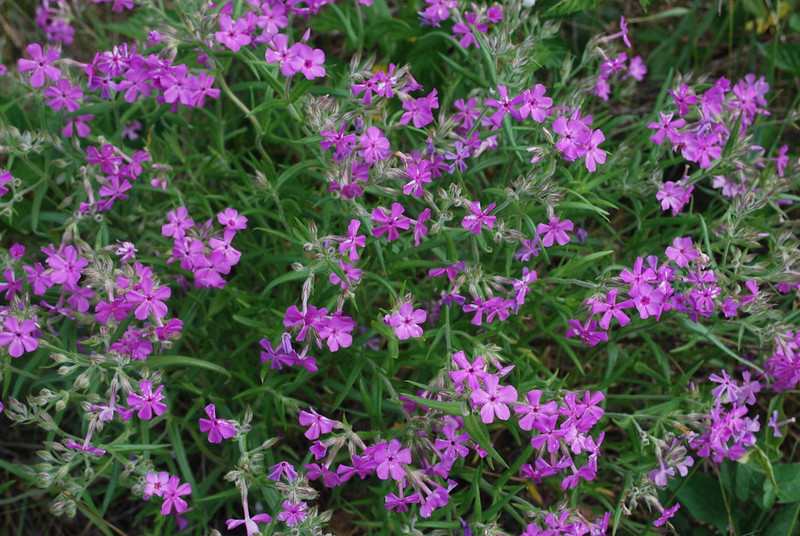
Photo Credit: Joshua Mayer / Flickr / CC BY-SA 2.0
Downy phlox, also called prairie phlox, blooms with fragrant purple flowers that attract butterflies. While it blooms in the summer, it may produce a second, sparser round of blooms in the fall. Moreover, the downy phlox seldom faces problems with diseases and insects; just look out for spider mites, which may sometimes be a problem during the heat of summer.
Plant type: Flower
Sun: Full sun
Water needs: Moderate
Soil: Fertile and moderately dry or moist, well-drained
Duration: Perennial
Mature height: 1 to 1.5 feet
Potential hazards: Lack of data; always practice caution
9. Black-Eyed Susan (Rudbeckia Hirta)
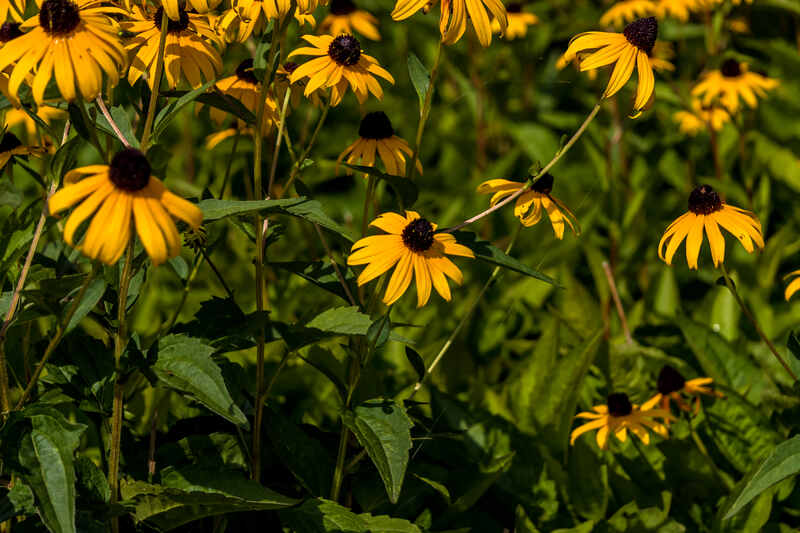
Photo Credit: Michel Rathwell from Cornwall, Canada / Wikimedia Commons / CC BY 2.0
If you want to add an easy-care, vibrant splash of color to your garden, consider planting black-eyed Susan. The cheerful yellow and black flower blooms within a year and stands up well to heat, drought, and cold.
Take caution, though; black-eyed Susan is toxic to animals. There’s a lack of data regarding its toxicity to humans, but it causes allergic reactions in some people. To be on the safe side, don’t consume it, handle it with gloves, and keep it away from pets.
Plant type: Wildflower
Sun: Full sun to partial shade
Water needs: Moderate
Soil: Average, well-draining, acidic
Duration: Perennial
Mature height: 2 to 3 feet
Potential hazards: Toxic
10. Zigzag Goldenrod (Solidago Flexicaulis)
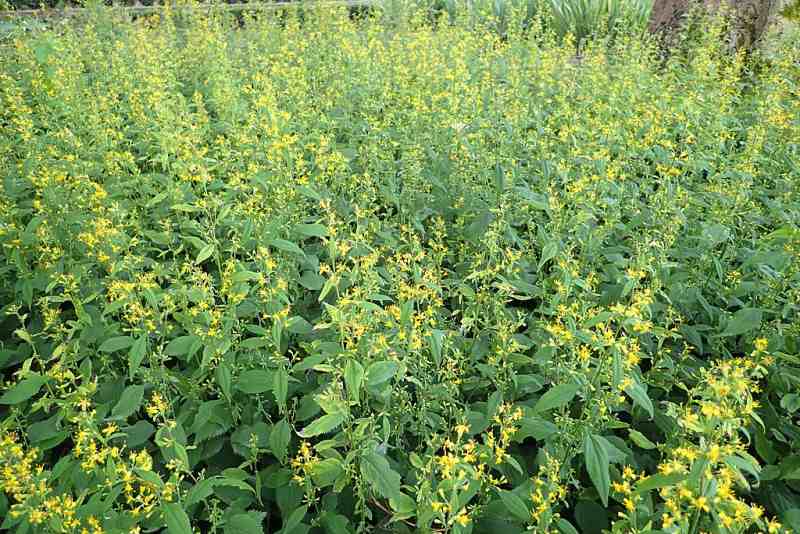
Photo Credit: Krzysztof Ziarnek, Kenraiz / Wikimedia Commons / CC BY-SA 4.0
If you want to plant beautiful tall trees or perhaps add some hardscapes to your outdoor area, zigzag goldenrod is a a great accent piece. It provides your lawn with a pop of yellow whether it grows in full sun or some shade. Moreover, zigzag goldenrod attracts pollinators and rarely deals with diseases and insect pests.
Although goldenrod plants are sometimes used as a supplement, it’s important to consult a medical professional before doing so. Some people, like pregnant and nursing women or people with health problems, shouldn’t use goldenrod supplements. Furthermore, it’s important to note that some species of goldenrod, such as rayless goldenrod, are toxic to some animals.
Plant type: Flower
Sun: Full sun to full shade (prefers partial shade)
Water needs: Moderate
Soil: Average, well-drained
Duration: Perennial
Mature height: 1 to 3 feet
Potential hazards: Goldenrod supplements may have side effects, so consult a professional before taking them; some goldenrod species are toxic to some animals, and there’s a lack of data about the Solidago flexicaulis species, so practice caution and don’t let animals eat them
11. Wild Hydrangea (Hydrangea Arborescens)
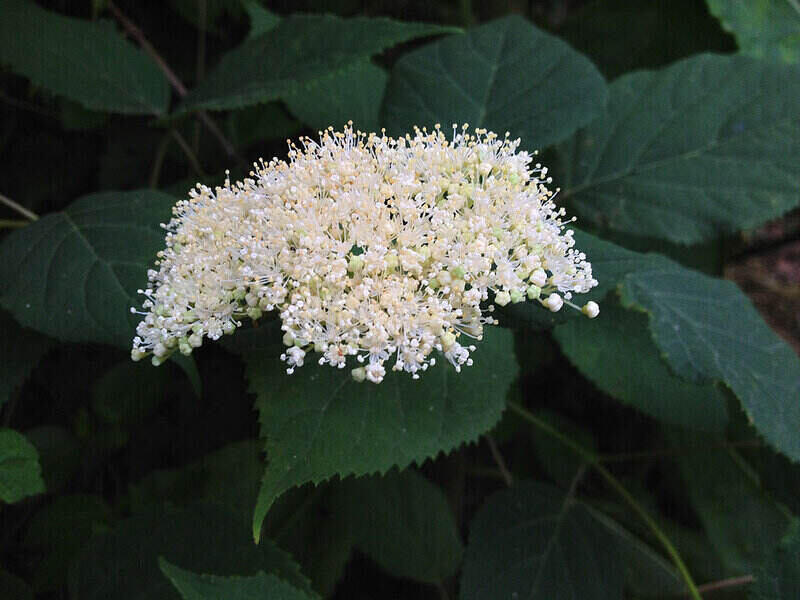
Photo Credit: Fritzflohrreynolds / Wikimedia Commons / CC BY-SA 3.0
Wild hydrangea is a showy plant that’s also listed on the Missouri Botanical Garden’s Plants of Merit, meaning that it grows outstandingly well in Missouri and the surrounding regions. It tolerates a variety of soils as long as it gets enough moisture. Because wild hydrangea grows well in wet soils, it’s a perfect choice for a rain garden. However, the plant is susceptible to some diseases and insect pest problems, so it needs some extra care.
Be cautious, though, because all parts of this plant are toxic if ingested.
Plant type: Shrub
Sun: Partial shade
Water needs: Moderate
Soil: Rocky, shallow, clay, average
Duration: Perennial
Mature height: 3 to 5 feet
Potential hazards: Toxic
12. Flowering Dogwood (Cornus Florida)
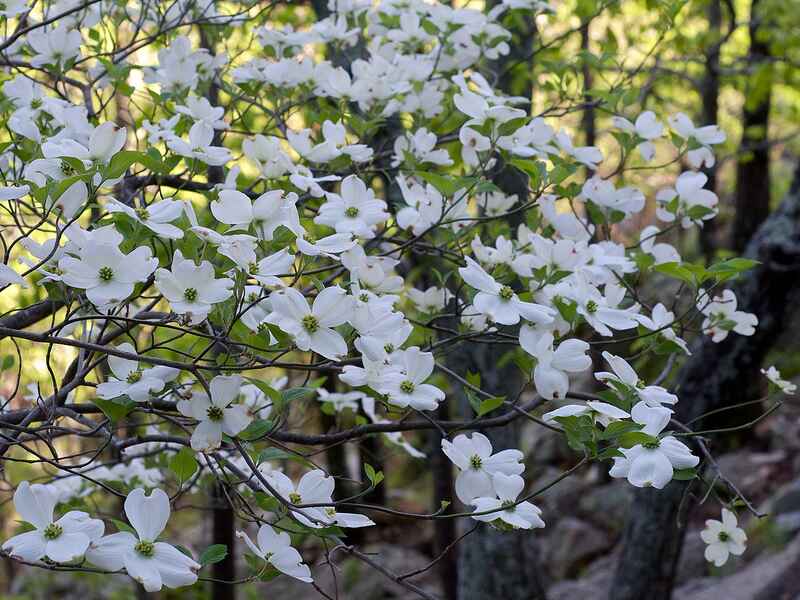
Photo Credit: Eric Hunt / Wikimedia Commons / CC BY-SA 4.0
Flowering dogwood is a spring bloomer that looks great and attracts wildlife. Bees and butterflies enjoy its nectar and use it to lay eggs, and birds feast on its red berries in the fall. With its spring flowers and fall berries, flowering dogwood can help your yard stand out throughout the year. However, take note that the tree is susceptible to some diseases, and will need moderate maintenance.
Also, it’s important to know that the tree, including the berries, is very poisonous to humans and pets. Never consume any part of it; leave it for local wildlife instead.
Plant type: Small tree
Sun: Full sun, partial shade; prefers partial shade
Water needs: Can handle occasional dryness; prefers moist, acidic, well-drained soil
Soil: Prefers high organic matter content; will tolerate sand, loam, and clay mixes
Duration: Perennial
Mature height: 12 to 30 feet
Potential hazards: Toxic
13. Pawpaw (Asimina Triloba)
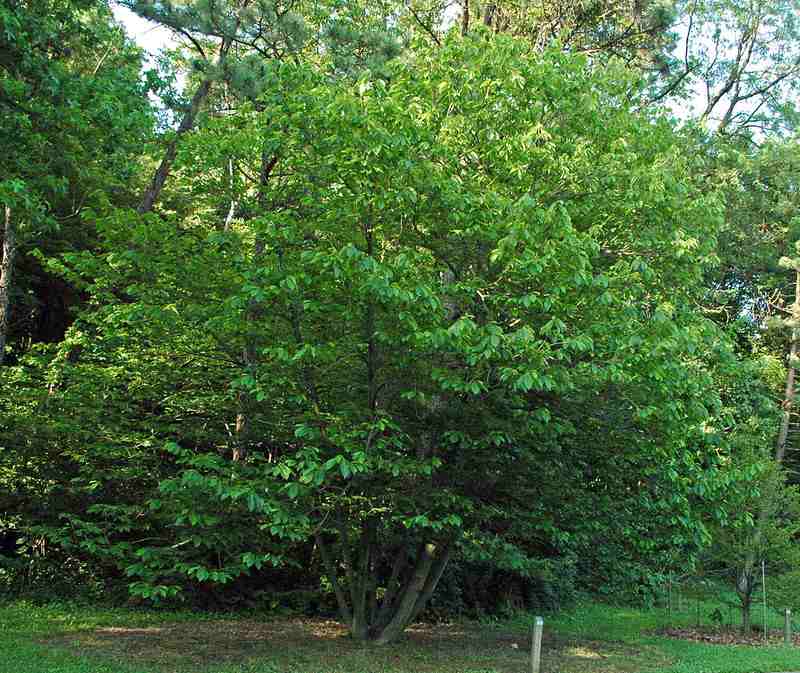
Photo Credit: James St. John / Flickr / CC BY 2.0
Pawpaw offers a touch of tropical beauty with purple flowers in spring and fruits that mature in early fall. It’s a favorite snack of various pollinators, birds, and other wildlife like squirrels and raccoons. Because the tree likes moist soil, it’s ideal for a rain garden.
However, even though pawpaw is commonly seen as edible, it’s actually been found to contain harmful chemical compounds with toxic effects. You can consult a medical professional if you want to discuss the safety of the fruit. Avoid feeding it to your pets.
Plant type: Tree
Sun: Full sun to partial shade; prefers full sun
Water needs: Keep soil moderately moist to wet but well-drained
Soil: Tolerates average soil; prefers fertile, acidic soils
Duration: Perennial
Mature height: 15 to 30 feet
Potential hazards: Contains harmful toxins
How to Create a Stunning Missouri Yard
For more information about native plants, you can check out GrowNative.org, where you can find a comprehensive list of plants that are native to Missouri.
With such a wide selection of native plants, you can create a yard that not only looks beautiful but also supports local wildlife. Make sure you also pick one of the best grasses for Missouri to complement your plant selection.
Once you pick the right plants and grass, you’re not done just yet. Your yard will need regular maintenance to thrive. If you’d like some help from a pro, get in touch with one of Wikilawn’s lawn care pros in Missouri.
Main Photo Credit: Missouri Botanical Garden / Pixabay